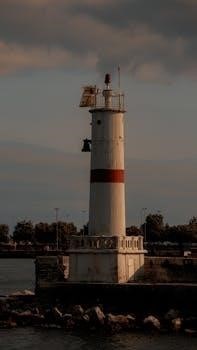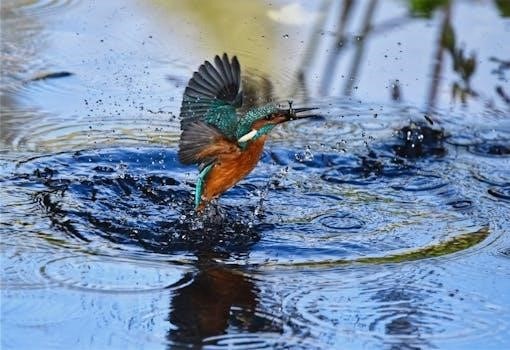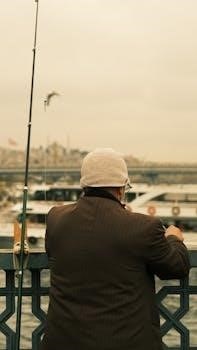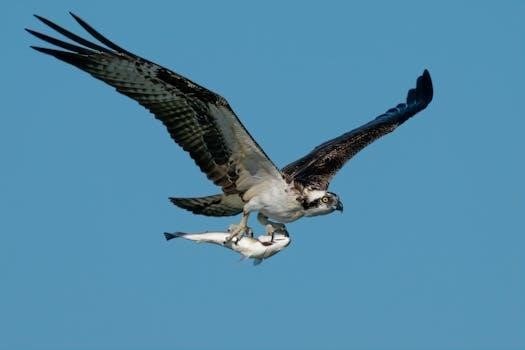Fly Fishing Guide Tipping⁚ A Comprehensive Guide
Tipping a fly fishing guide is a customary practice, showing appreciation for their expertise and service. The standard tip ranges from 15% to 25% of the trip cost. This guide explores tipping etiquette, helping you navigate this aspect of guided fly fishing.
Understanding the Custom of Tipping Fly Fishing Guides
Tipping fly fishing guides is deeply ingrained in the sport’s culture. It’s more than just an afterthought; it’s an acknowledgment of the guide’s dedication, knowledge, and effort in creating a memorable and successful experience. This custom stems from the understanding that guides often go above and beyond to ensure their clients have a rewarding day on the water.
Guides invest significant time scouting locations, preparing equipment, and tailoring their approach to match the angler’s skill level and preferences. They share their expertise on local waters, fly selection, and casting techniques. Their goal is to maximize the angler’s chances of catching fish and enhance their overall enjoyment of the trip.
Furthermore, tipping acknowledges that a guide’s income relies, in part, on gratuities. While they receive a base rate for their services, tips provide a financial incentive for guides to excel and deliver exceptional service. It’s a way for anglers to directly reward guides who exceed expectations and demonstrate a genuine passion for fly fishing and client satisfaction. The custom also provides flexibility in the rate.
Standard Tipping Percentages⁚ 15-25% Explained
The generally accepted tipping range for fly fishing guides falls between 15% and 25% of the total cost of the guided trip. This range provides a guideline, allowing anglers to adjust the tip based on various factors, primarily the quality of service received. A tip of 15% typically signifies satisfactory service, indicating that the guide met expectations and provided an enjoyable experience.
Moving towards the higher end, a 20% tip suggests that the guide exceeded expectations, demonstrating expertise, attentiveness, and a genuine commitment to ensuring the angler had a successful and memorable day. A tip of 25% or more is reserved for exceptional service, where the guide went above and beyond to cater to the angler’s needs, sharing extensive knowledge, providing personalized instruction, and creating an unforgettable experience.
It’s important to note that these percentages are guidelines and can be adjusted based on individual circumstances. However, understanding the standard range provides a solid foundation for determining an appropriate tip amount.
Factors Influencing Tip Amount⁚ Service Quality

Service quality is a primary determinant of the tip amount for a fly fishing guide. A guide’s professionalism, communication skills, and attentiveness significantly impact the overall experience and, consequently, the tip.
A high-quality guide demonstrates excellent communication, clearly explaining techniques, strategies, and safety procedures. They are attentive to the angler’s needs, providing assistance and guidance as required. Furthermore, a professional guide is punctual, well-prepared, and respectful of the angler and the environment. Positive interactions and a genuine desire to ensure the angler’s enjoyment contribute to a higher tip.
Conversely, poor service quality may warrant a reduced tip or, in extreme cases, no tip at all; Examples of poor service include a guide who is unprepared, unprofessional, or demonstrates poor communication. If a guide is consistently late, provides inadequate instruction, or displays a lack of concern for the angler’s safety or enjoyment, a lower tip may be appropriate.
Ultimately, the tip should reflect the angler’s satisfaction with the service provided. Clear communication and addressing concerns during the trip can help ensure a positive outcome.
Factors Influencing Tip Amount⁚ Guide’s Effort and Expertise
A guide’s effort and expertise are significant factors influencing the tip amount. Demonstrating extensive knowledge of the local waters, fly fishing techniques, and fish behavior showcases expertise. Guides who proactively share their knowledge and tailor their approach to the angler’s skill level deserve a higher tip.
Effort encompasses a guide’s willingness to go the extra mile to ensure a successful and enjoyable trip. This includes scouting locations, adapting to changing conditions, and providing personalized instruction. A guide who works tirelessly to find fish, even when conditions are challenging, demonstrates a strong commitment.
Furthermore, a guide’s ability to troubleshoot problems, offer solutions, and maintain a positive attitude contributes to a favorable experience. Their dedication to safety, ensuring the angler’s well-being, also warrants consideration.
Conversely, a guide who appears disinterested, unprepared, or unwilling to put in the effort may receive a lower tip. A lack of expertise, such as an inability to locate fish or provide effective instruction, can also negatively impact the tip amount. The tip should reflect the angler’s assessment of the guide’s effort and the value of their expertise.
Factors Influencing Tip Amount⁚ Fishing Success vs. Overall Experience
While fishing success is often a factor, the overall experience should weigh heavily in determining the tip amount. A guide cannot control weather or fish behavior, so judging solely on the number of fish caught is unfair. Focus instead on the guide’s effort and the quality of the experience.
A knowledgeable and engaging guide who creates a positive and educational atmosphere deserves a generous tip, even if the fishing is slow. Their ability to teach new techniques, share insights about the local ecosystem, and maintain a good attitude contributes significantly.
Consider the guide’s communication skills, patience, and willingness to adapt to your needs. A guide who prioritizes your enjoyment and learning, regardless of fishing success, demonstrates exceptional service.
Conversely, a guide who is unhelpful, uncommunicative, or seems disinterested should receive a lower tip, even if you catch fish. Poor service can detract from the overall experience, regardless of fishing success. The tip should reflect your satisfaction with the entire experience, not just the number of fish landed.
Ultimately, tipping is a personal choice. Factor in fishing success, but prioritize the guide’s effort, expertise, and the overall quality of the experience.
Tipping When Bringing Your Own Equipment
It is still customary to tip a fly fishing guide even if you bring your own equipment. Tipping isn’t solely about compensating for the use of gear; it’s primarily a gesture of appreciation for the guide’s expertise, knowledge of the local waters, and overall service provided during your fishing experience.
Even with your own equipment, the guide contributes significantly to your success and enjoyment. They provide valuable insights into the best fishing spots, techniques, and strategies tailored to the specific location and conditions. Their expertise in reading the water, understanding fish behavior, and adapting to changing circumstances is invaluable.
Furthermore, the guide ensures your safety and well-being throughout the trip. They navigate the waters, monitor weather conditions, and provide assistance as needed. Their presence allows you to focus on fishing and enjoy the experience without worrying about logistics or potential hazards.
Therefore, tipping is a way to acknowledge the guide’s efforts in enhancing your fishing experience, regardless of whether you use their equipment or your own. The standard tipping percentage (15-25%) applies even when you bring your own gear. Consider the quality of service, the guide’s expertise, and your overall satisfaction when determining the tip amount.
Tipping in Lodge vs. Independent Guide Scenarios

Tipping etiquette can differ slightly depending on whether you’re fishing with a guide at a lodge or an independent guide. In a lodge setting, it’s common for tips to be pooled and distributed among the entire staff, including guides, cooks, and housekeeping. The lodge may have specific guidelines for tipping, such as a recommended percentage of the overall package price.
In this scenario, a tip of 7-12% of the total cost is appropriate. Ensure if you are tipping the guide directly that it is above 40-60 dollars. If you wish to recognize a guide’s exceptional service, consider providing a separate tip directly to them. With independent guides, tipping is more straightforward. You directly compensate the guide based on the quality of their service and your overall satisfaction.
The standard tipping percentage (15-25%) typically applies. Consider factors like the guide’s expertise, effort, and the overall experience when determining the tip amount. Remember, lodge packages often cover various services, so the tip is distributed accordingly. With independent guides, your tip directly rewards their individual contribution to your fishing trip. Understanding these nuances ensures you appropriately acknowledge the services provided in different guiding scenarios.
Handling Poor Service⁚ Communication and Alternatives to Tipping
Encountering poor service from a fly fishing guide presents a challenging situation regarding tipping. While tipping is customary, it’s also tied to the quality of service received. If the guide’s performance falls short due to factors within their control, such as unprofessionalism, lack of effort, or poor communication, adjusting or withholding the tip becomes a consideration. However, it’s essential to approach this situation with tact and open communication.
Before deciding not to tip, or to reduce the tip amount, communicate your concerns directly to the guide. Provide constructive feedback, explaining the specific issues that detracted from your experience. This allows the guide an opportunity to address the problems and potentially improve the situation. If direct communication proves unfruitful, consider speaking with the outfitter or lodge manager to voice your concerns.
In cases of genuinely poor service, alternatives to a full tip might be appropriate. Offering a smaller tip (around 10%) while clearly explaining your dissatisfaction can be more effective than no tip at all. This conveys your disappointment while leaving room for improvement. Ultimately, the goal is to address the issue constructively and fairly.
When and How to Present the Tip
The appropriate time to present a tip to your fly fishing guide is generally at the end of the trip, after you’ve returned to the dock or concluded the day’s fishing activities. This allows you to fully assess the guide’s services and determine a suitable amount based on your overall experience. It’s customary to present the tip directly to the guide as a gesture of appreciation for their efforts.
As for the method, cash is the most common and appreciated form of tip. It’s discreet and allows the guide immediate access to the funds. If you prefer to use a check, ensure it’s made out to the guide personally, not to the outfitter or lodge, unless instructed otherwise.
Present the tip in a private and respectful manner. A simple “Thank you for a great day of fishing. I really appreciate your help and expertise” can accompany the tip. Avoid making a public spectacle of the transaction, as it can be uncomfortable for both you and the guide. If you are paying with a check, it is important to ensure that the check will be available in time.

Tipping Multiple Guides or Crew Members
When your fly fishing experience involves multiple guides or crew members, distributing tips requires careful consideration. If each guide provided distinct and significant assistance, it’s appropriate to tip them individually, assessing their contributions separately. For example, if one guide excelled at spotting fish while another focused on teaching casting techniques, you might adjust the tip amounts to reflect their respective strengths.
Alternatively, if the guides worked collaboratively as a team, you can provide a lump sum to be divided among them. In this scenario, inquire about the standard practice for tip distribution. The head guide or outfitter can typically advise on the fairest way to allocate the funds.
For larger operations with dedicated crew members, such as boat operators or cooks, it’s customary to tip them as well. A general guideline is to allocate a percentage of the overall tip pool to these individuals, proportionate to their role and level of service. Communication is key to ensure that all deserving individuals are appropriately acknowledged for their contributions to your fishing experience.
Regional Differences in Tipping Expectations (US vs. Europe)
Tipping customs vary considerably between the United States and Europe, influencing expectations for fly fishing guides. In the US, tipping is deeply ingrained, and guides often rely on gratuities to supplement their income. A standard tip of 15-25% is customary for satisfactory service, with higher amounts for exceptional experiences. Failing to tip can be seen as a sign of dissatisfaction.
In contrast, Europe generally has lower tipping expectations. While tipping is appreciated for excellent service, it’s not always considered mandatory. In some European countries, service charges are included in the overall price, reducing the need for additional tipping. When considering tipping a fly fishing guide in Europe, research local customs beforehand. A tip of 5-10% might be appropriate for outstanding service, but exceeding 15% is usually unnecessary. It’s always wise to discreetly inquire about local norms to ensure you’re adhering to customary practices and showing appropriate appreciation.

Beyond Monetary Tips⁚ Alternative Ways to Show Appreciation
While monetary tips are the standard way to express gratitude to a fly fishing guide, there are several alternative ways to show your appreciation. A heartfelt thank-you goes a long way, acknowledging their effort and expertise. Positive reviews online or referrals to friends can significantly boost their business. Sharing photos or videos from your trip, with their permission, showcases their guiding skills and creates valuable content for them.
Offering a small, thoughtful gift related to fishing or the local area can be a memorable gesture. Consider items like high-quality fishing tools, local delicacies, or a handwritten note expressing your gratitude. Providing refreshments or lunch during the trip can also be appreciated; Most importantly, maintain open communication and express your genuine appreciation for their knowledge, patience, and dedication to making your fly fishing experience enjoyable. Remember that your words and actions can be just as impactful as a monetary tip.